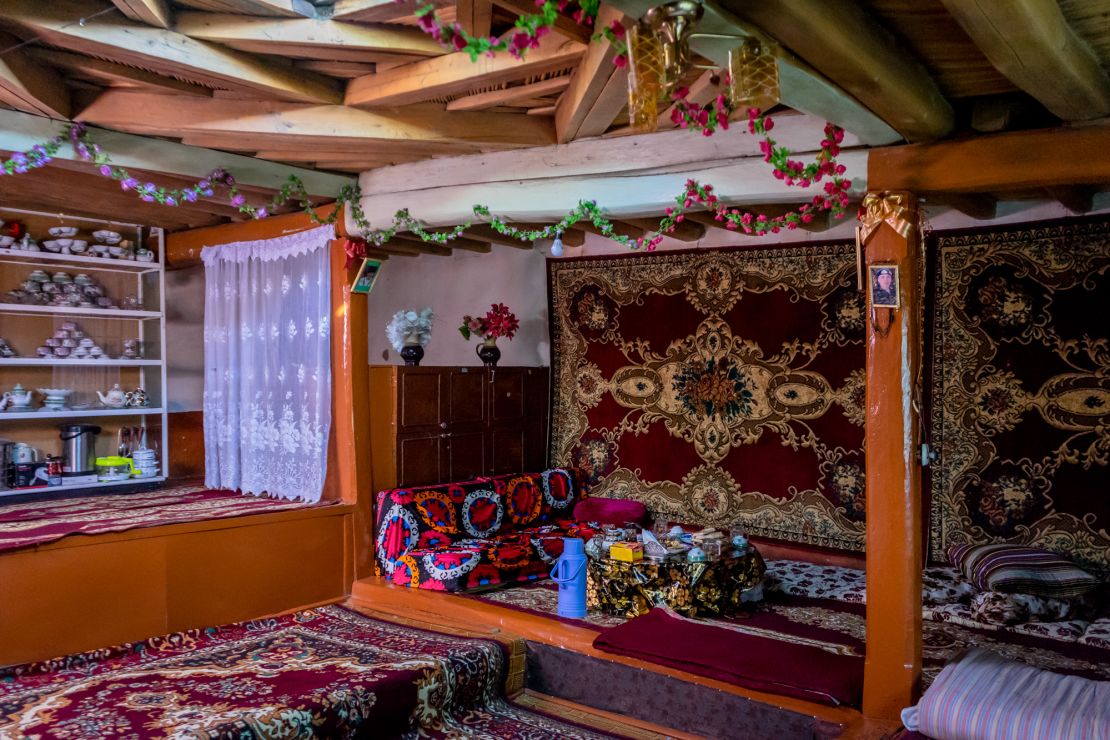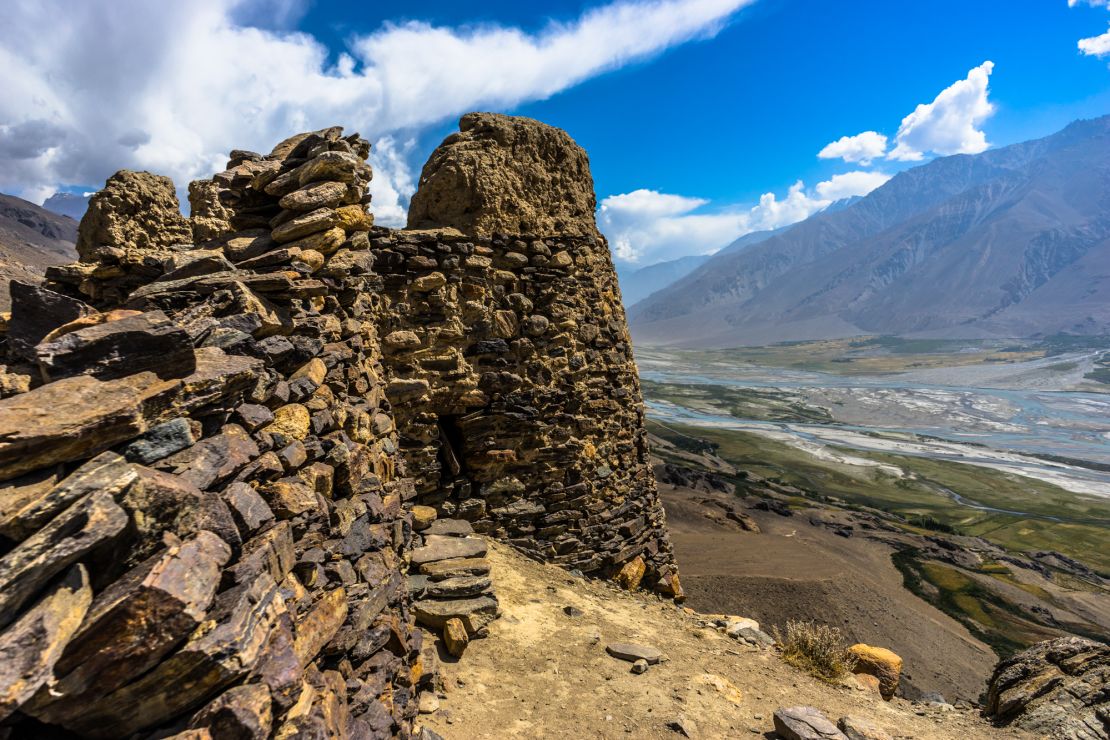A weathered sign indicated our altitude on Tajikistan’s Ak-Baital Pass – 4,655 meters above sea level.
Barren mountains stretched in every direction, casting shadows over the second-highest international road in the world. China loomed over the eastern horizon. Kyrgyzstan was behind us. To the south lay Afghanistan and the fabled Wakhan Corridor.
We were heading south, along the Pamir Highway, officially known as the M41.
Celebrated as one of the planet’s most intrepid road trips, this 2,038-kilometer-long road navigates through the sands of Central Asia into the heart of isolated ranges.
First stop: Sary Moghul
The appeal of staying in local homestays and immersing in the Muslim culture is what brought us to this semi-paved, high-altitude trail, home to about 120,000 Pamiri minority people.
Setting out from Osh, Kyrgyzstan, my fiance and I hired a 4x4 and a gregarious driver named Mohammed from the Osh Guesthouse.
Under the hotel owner’s guidance we drew up a rough, seven-day itinerary that would lead us along the Pamir Highway and into the Wakhan Valley, on the Afghan border.
We began our drive through the plateaus outside Osh on a bright Saturday morning, bound for the village of Sary Moghul.
Near the base of the 7,143-meter tall Peak Lenin, Sary Moghul is a charming town that attracts hikers and mountaineers from around the globe.
The town has just enough appeal to warrant a day’s exploration. We spent the afternoon wandering the dirt roads and playing a game of football with a group of young boys.
Endless highway: How to drive the ultimate American road trip

Entering Central Asia’s no-man’s-land
After a comfortable night in the bustling Community Based Tourism guesthouse, we set off for the 25-kilometer stretch of no-man’s-land that separates Kyrgyzstan and Tajikistan.
At the border Mohammed took care of the necessary “paperwork” to allow us to cross.
Apparently our official visas weren’t enough.
Later we asked Mohammed how much he had to pay the guards.
“Too much,” he replied soberly.
Craggy and desolate mountains converted the landscape as we continued to gain altitude. The scenery would stay that way until we reached the lush Wakhan Valley.
Karakul Lake appeared like a shimmering mirage on the horizon as we pulled into its waterside village for the evening. We dropped our bags off at Sadat’s Homestay and immediately set about exploring the concrete town.
The shell of a Soviet tank lay buried on the edge of an abandoned prison and soldiers played volleyball with the villagers. Life in Karakul is unhurried, and we took this relaxed atmosphere back with us to Sadat’s as night fell. For $12 a head, the family offered a bed and three delicious home-cooked meals.
Traditional Pamiri houses are built with strong symbolism to their Ismaili faith, which is a secretive branch of Islam.
They have five supporting pillars, representing each member of their prophet Ali’s family, and four square layers in the ceiling, expressive of the Zoroastrian elements of fire, air, water and earth.
We slept on blankets on a colorful, carpeted floor; a wood fire stove heated the room throughout the night.

Travel restrictions
With the Taliban threat still present in Afghanistan, Tajikistan has placed travel restrictions on foreigners.
The Pamir Highway runs through the Gorno-Badakhshan Autonomous Oblast (GBAO) and special permits are required to travel in the region.
These are easily attained at Tajik embassies. We collected ours in one day in Bishkek.
Our permits allowed passage through the various military checkpoints as we made our way from Karakul to the small town of Murghab, which sits inside the GBAO.
We spent the next few days hiking around the vast Bulunkul Lake, drinking tea with local shepherds and stocking up on supplies in Murghab’s markets.
Where the M41 Pamir Highway veers inland to Khorog, we turned towards the border of Afghanistan, leaving the paved road and committing to two days of sand, dust and captivating scenes of the Hindu Kush.
The Panj River flowed into sight, carving out the valley and forming the official border between the two nations.
17 trips that can change your life
Where old empires collide
The Wakhan Corridor – a narrow, finger-like stretch of Afghanistan high in the Hindu Kush mountains – is the result of border divisions during the Great Game, a 19th century political battle between Russia and Britain.
The curious lines on a map are only one indication of the years of turmoil that have plagued this area.
More telling are the 2,200-year-old ruined fortresses that remain perched on the hillsides in Langar, Yamchun and Ishkashim – important and fertile villages along the Panj River.
Today they’re spectacular sites to explore, offering commanding views over Afghanistan’s snow-capped mountains and gorges.
A Buddhist shrine,10,000-year-old petroglyphs and a fascinating museum in Yamg village broke up our road trip through the region, educating us on the diverse range of ethnic cultures that have inhabited the Wakhan.
Every village we drove through had kids running alongside the 4x4, waving and calling out “hello” in genuine excitement.
Each host in our superb homestays asked us to encourage other travelers to visit.

A heated conversation
In Yamchun, the Bibi Fatima hot springs attract locals and travelers alike, seeking to improve their fertility by soaking in the mineral waters.
Men and women are separated, keeping with the modest customs of the Islamic faith. Stripping completely, I stepped into the grotto-like bath and was greeted by three Tajik men. They were talking in the local Pamiri language.
“As-Salaam-Alaikum,” they addressed me. Peace be upon you.
“Wa-Alaikum-us-Salaam,” I replied. And peace be upon you.
The men switched to broken English, asking me about my time in their country. Many Pamiris are learning English to work in the growing tourism industry.
“You and your friends are always welcome in Tajikistan,” they said proudly, before leaving me in the hot springs.
‘They can’t wait to meet you’
The twists and turns in the road continued as our final day led us to Khorog, and the end of our journey.
Mohammed bid farewell to us at the Pamir Lodge, hurriedly returning to Osh in the hope of picking up more customers before winter arrived.
A handful of eager travelers were waiting in the lodge to start their own adventure, reversing the route we had just taken. We traded tips and stories beneath a crisp and clear autumn evening.
“What are the people like?” one young man asked me. I smiled, and thought about the shepherds, hosts and kids we had encountered along the way.
“Very welcoming,” I answered. “They can’t wait to meet you.”
Local info
With no hotels outside of the larger towns of Murghab and Khorog, local homestays and camping are the only accommodation options on the Pamir Highway.
This lack of amenities ensures only dedicated travelers visit Tajikistan.
Today, the Pamir Highway has become a pilgrimage of sorts for cyclists, motorcyclists and four-wheel-drive enthusiasts, who frequent the region in summer. Some visitors book expeditions through travel agencies and tour companies abroad.
But it’s easy to organize logistics on arrival – often for cheaper – with funds going directly to local operators.
Otherworldly travel destinations here on Earth
Jarryd Salem is a freelance writer who has been exploring the world nonstop since 2007. More of his stories can be found at Nomadasaurus.com.


















